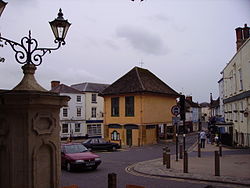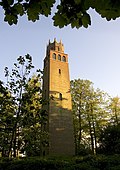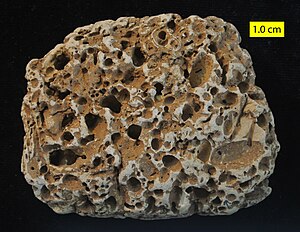Faringdon
| Faringdon | |
| Berkshire | |
|---|---|
 Faringdon market place | |
| Location | |
| Grid reference: | SU286954 |
| Location: | 51°39’25"N, 1°35’10"W |
| Data | |
| Population: | 6,187 (2001) |
| Post town: | Faringdon |
| Postcode: | SN7 |
| Dialling code: | 01367 |
| Local Government | |
| Council: | Vale of White Horse |
| Parliamentary constituency: |
Wantage |
| Website: | Faringdon Town Council |
Faringdon is a small market town in the north-western corner of Berkshire. It is on the edge of the Thames Valley, between the River Thames and the Ridgeway.
The village forms a civil parish, formally known as Great Faringdon, to distinguish it from Little Faringdon in Oxfordshire.
History
The name Faringdon means fern covered hill. The Kings of the West Saxons are believed to have had an estate and hall in Faringdon.
In the Domesday Book of 1086, Faringdon is recorded as a manor and a mill. The town was granted a weekly market in 1218.[1] The weekly market is still held today. King John also established an abbey in Faringdon in 1202, (probably on the site of Portwell House) but it soon moved to Beaulieu in Hampshire.[1]
Parish church

The parish church is All Saints. The church may date from the 12th century, and the clerestorey and possibly the west end of the nave survive from this period.[1] A Norman doorway survives, although not in its original position, in the baptistery.[2] The chancel and north transept are 13th century and the west chapel is 14th century.[2] The north chapel is a late mediæval Perpendicular Gothic addition[2] with 15th century windows.[1]
All Saints has a central bell tower, which was reduced in height in 1645 after it was damaged by a cannon-ball in the English Civil War.[1] Faringdon was fought over because it commands the road to the Radcot Bridge over the River Thames. The tower now has a ring of eight bells.[3] The three oldest bells were cast in 1708.[1] James Wells of Aldbourne in Wiltshire cast the tenor bell in 1779 and another bell in 1803.[1] The three youngest bells, including the treble, were cast in 1874 by Mears and Stainbank.[1]
Other Buildings
Old Town Hall
The Old Town Hall (formerly the Market Hall) dates from the late 17th century or early 18th century.[1][4] It remains the centre of the town and its focal point.
The £1.6 million three-mile A420 bypass opened in July 1979.
Faringdon Folly

Just east of the town is Folly Hill or Expression error: Unexpected < operator.&y=Expression error: Unexpected < operator.&z=120 Faringdon Hill, a greensand outcrop. In common with Badbury Hill to the west of the town, it has an ancient ditched defensive ring; a hill fort. At some time during the Anarchy (1135–1141) the hill was fortified by supporters of Matilda as she strove to claim the throne from King Stephen. Matilda's works were razed to the ground by Stephen. Oliver Cromwell fortified the hill in his unsuccessful campaign to defeat the Royalist garrison at Faringdon House.
The Pye family had Scots Pines planted around the summit, around the time that Faringdon House was rebuilt in the late 18th century. This is a conspicuous and recognisable landmark that can be seen from afar, including from the Vale of White Horse, White Horse Hill, the Berkshire Downs near Lockinge and the Cotswold Hills to the north.
The folly on Folly Hill was designed by Gerald Wellesley, Marquess of Douro for Lord Berners and built in 1935.[5] It stands 140 feet high and affords panoramic views of the Vale of White Horse.[5] During the Second World War, the Home Guard used it as an observation post. In 1982 Robert Heber-Percy restored it and gave it to the town in trust.
Near the top of London Street near Faringdon Folly is the pub bearing the same name. Resembling a small living room with a bar placed in the middle, it is a popular haunt for those that like an "old fashioned pub".
Faringdon House
There is a manor house and estate, close to the edge of Faringdon, called Faringdon House. The original house was damaged during the English Civil War. Its owner at the time, Sir Robert Pye, who was a Royalist, was put under siege by his own son Robert who was a Parliamentarian colonel.[6]
Building of the current, smaller, began about 1780 and was not completed until after 1785.[7][8] It was the home of Lord Berners in the middle part of the twentieth century. It currently belongs to the writer Sofka Zinovieff, though she does not live there.
Geology

Faringdon is home to the famous Faringdon Sponge Gravel, a Cretaceous unit filled with spectacular fossil sponges, other invertebrates, a few vertebrate bones and teeth, and wonderful examples of bioerosion.
Culture

Faringdon is notable for the dyed pigeons at Faringdon House. The custom of dyeing pigeons was originally started by the eccentric Lord Berners.[9]. Around the town one can see a number of stone plaques with comments such as "Please do not throw stones at this notice" reflecting Lord Berners' ongoing influence on the Town.
Since 2004, Faringdon has held an annual arts festival over one weekend in early July.
References
- ↑ 1.0 1.1 1.2 1.3 1.4 1.5 1.6 1.7 1.8 Page & Ditchfield, 1924, pages 189-199
- ↑ 2.0 2.1 2.2 Pevsner, 1966, page 139
- ↑ Oxford Diocesan Guild of Church Bell Ringers: Vale of the White Horse Branch: Branch Towers
- ↑ Images of England website
- ↑ 5.0 5.1 Pevsner, 1966, page 142
- ↑ John Burke A genealogical and heraldic history of the commoners of Great Britain
- ↑ Faringdon On Line: Faringdon House
- ↑ Pevsner, 1966, page 140
- ↑ Lord Berners, Faringdon.org
Sources
- Page, W.H.; Ditchfield, P.H., eds (1924). A History of the County of Berkshire, Volume 4. Victoria County History. pp. 489–499.
- Pevsner, Nikolaus (1966). The Buildings of England: Berkshire. Harmondsworth: Penguin Books. pp. 139–142.